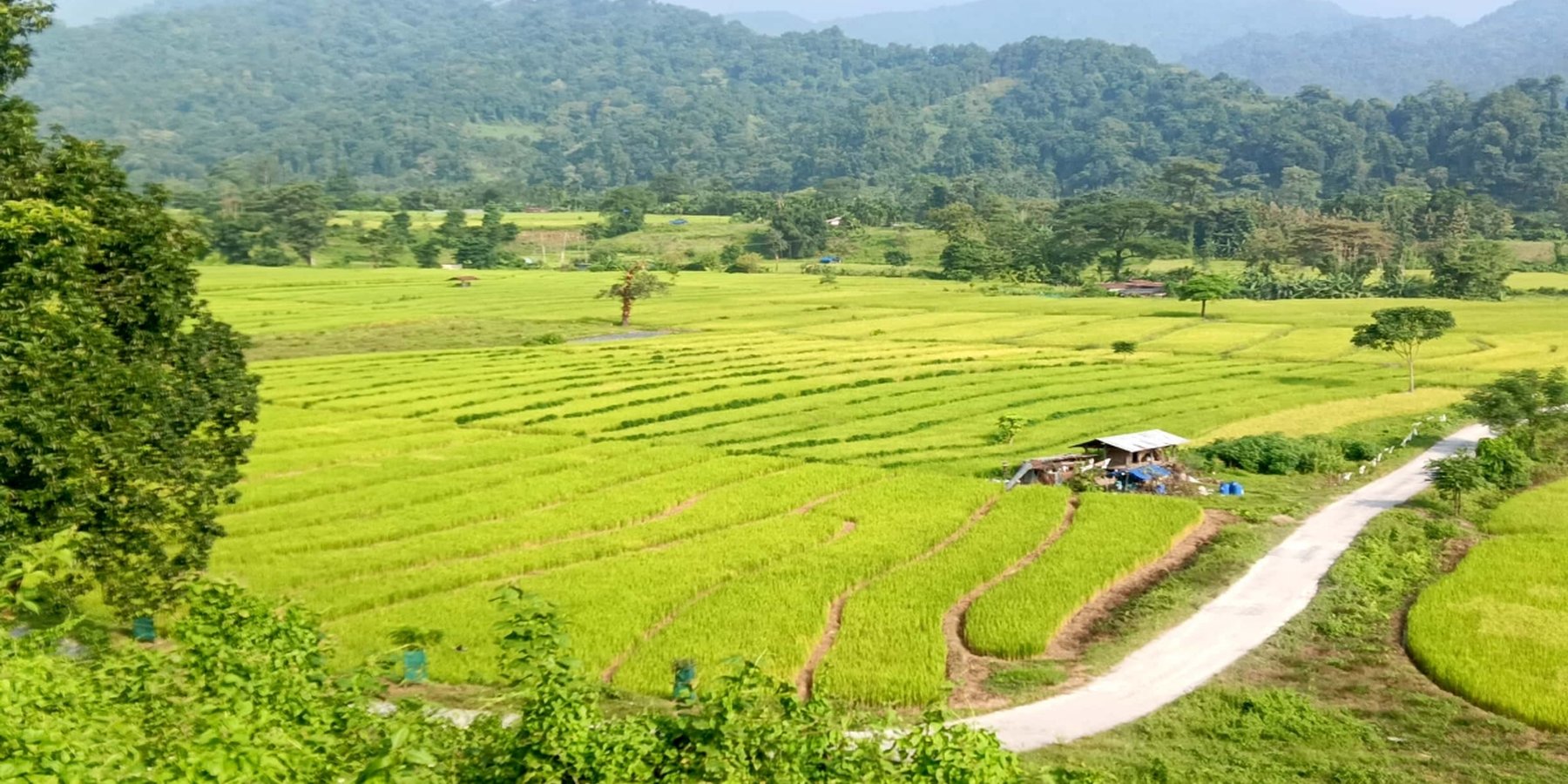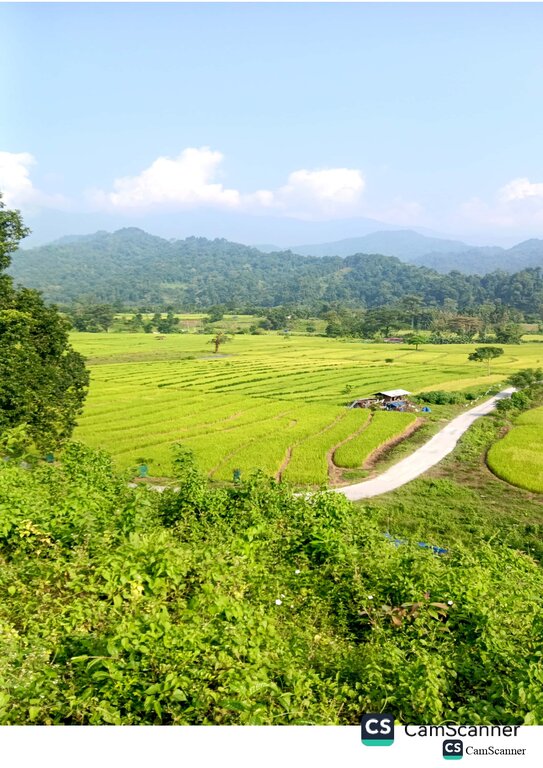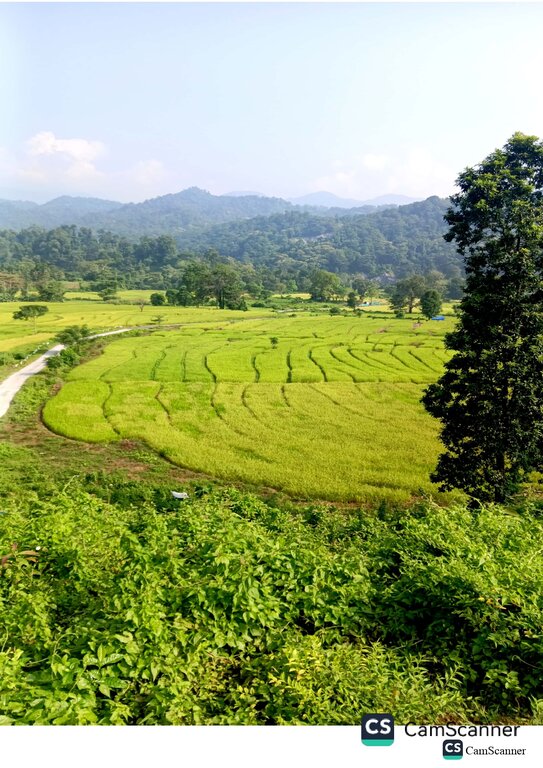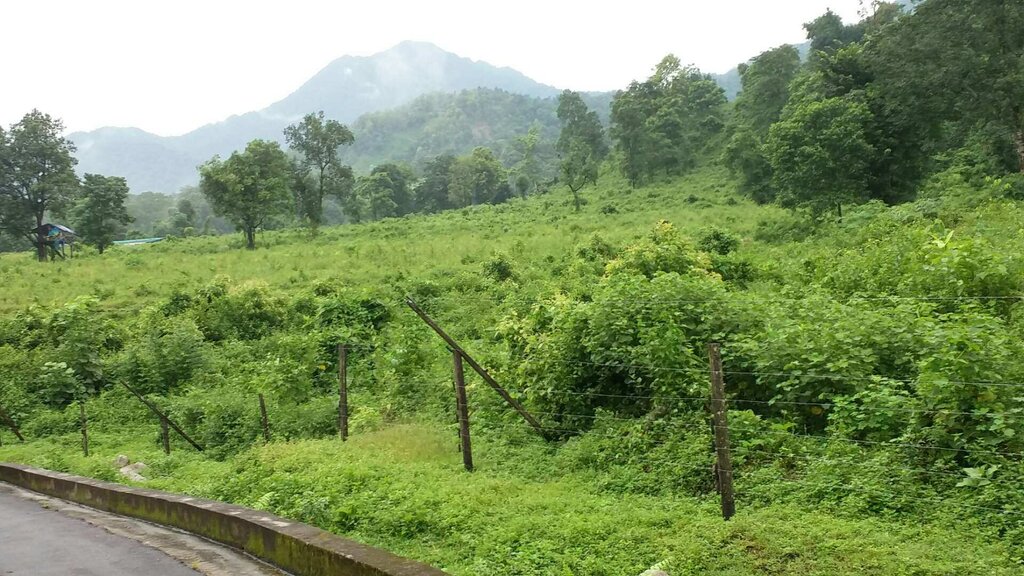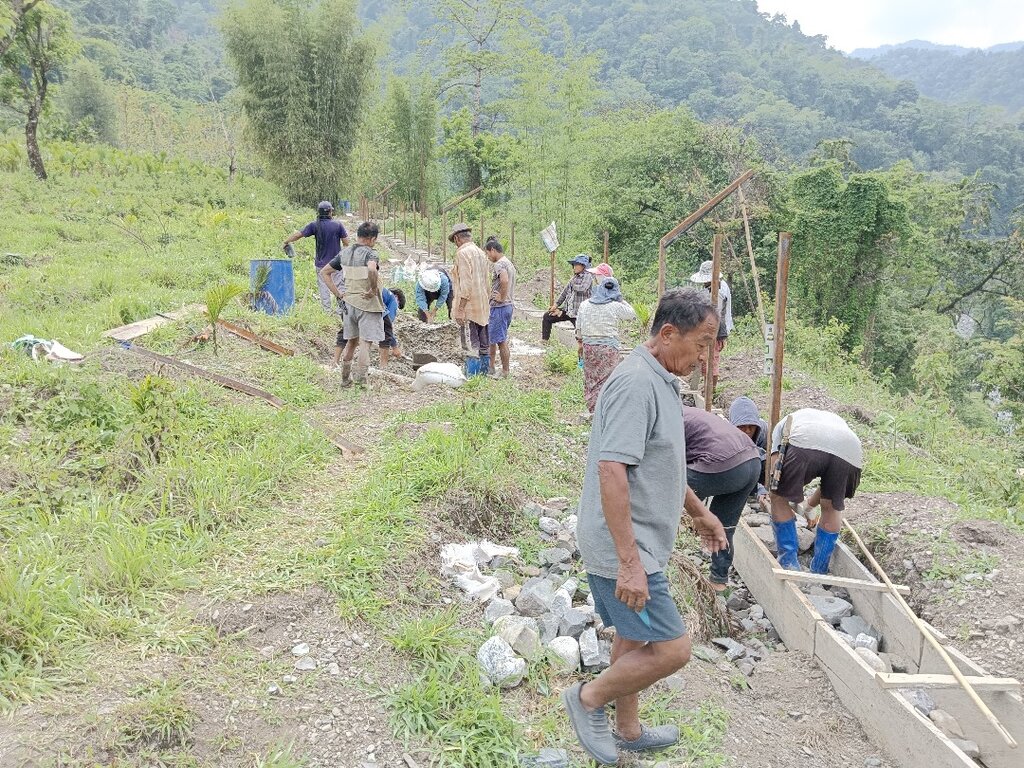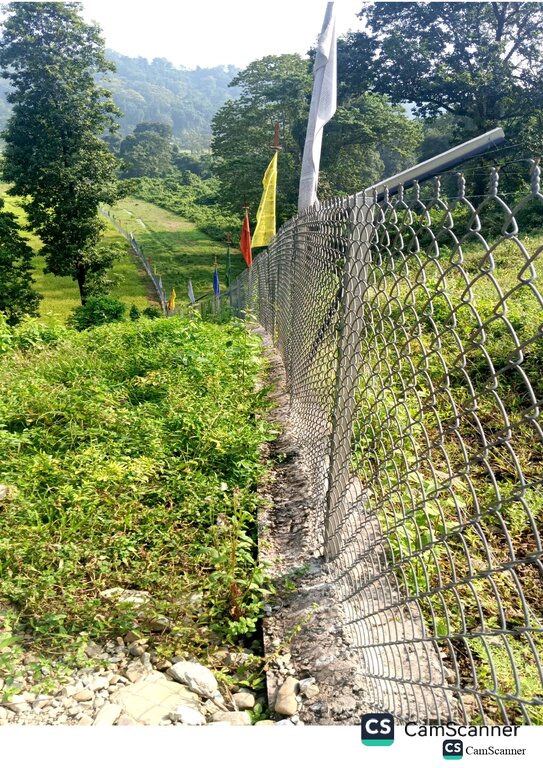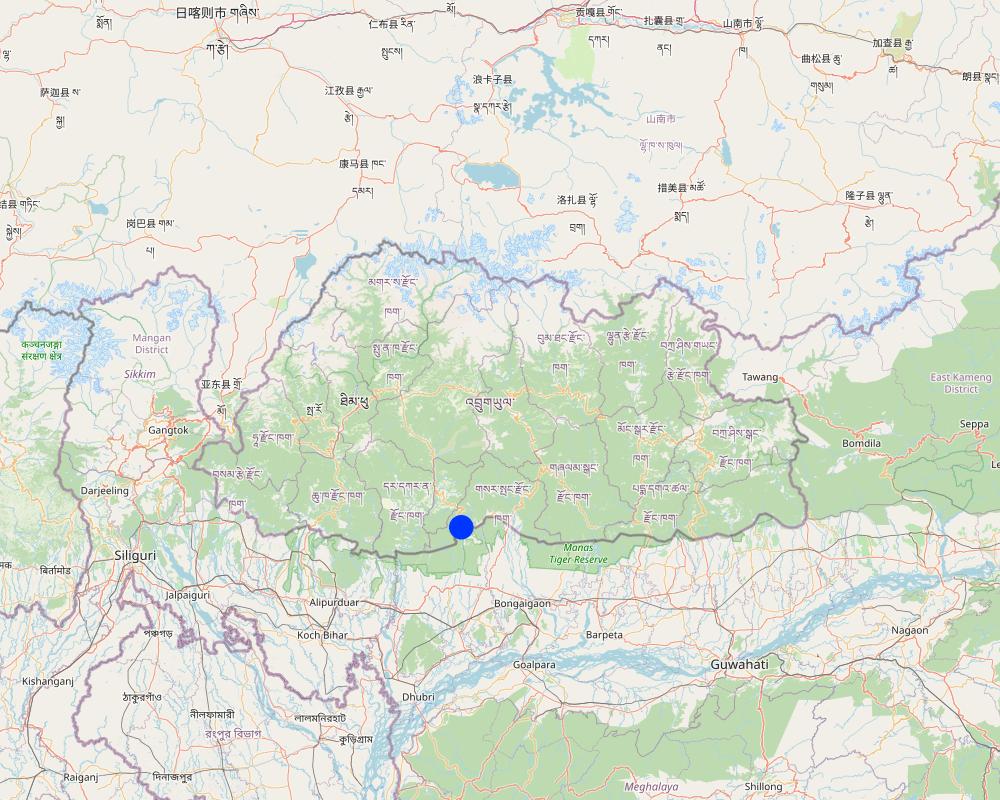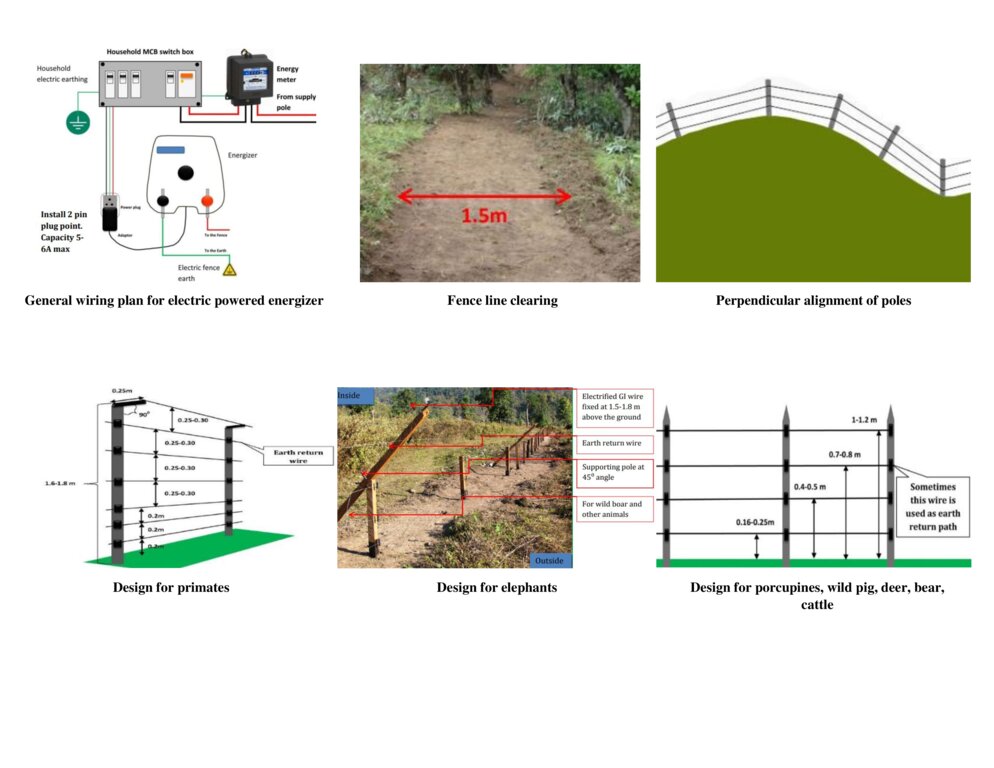Securing Food Through Electric Fencing [Бутан]
- Создание:
- Обновить:
- Составитель: Nima Dolma Tamang
- Редактор: Chenga Tshering
- Рецензенты: William Critchley, Rima Mekdaschi Studer
gLog-May-Raow
technologies_6830 - Бутан
Просмотреть разделы
Развернуть все Свернуть все1. Общая информация
1.2 Контактные данные специалистов и организаций, участвующих в описании и оценке Технологии
Ответственный (-ые) специалист (-ы)
землепользователь:
Tashi Tshering
Бутан
Gewog Agriculture Extension Officer:
Wangdi Thinley
Gewog Agriculture office, Senggye Gewog, Sarpang Dzongkhag
Бутан
Название проекта, содействовавшего документированию/оценке Технологии (если применимо)
Strengthening national-level institutional and professional capacities of country Parties towards enhanced UNCCD monitoring and reporting – GEF 7 EA Umbrella II (GEF 7 UNCCD Enabling Activities_Umbrella II)Название организации (-ий), содействовавших документированию/оценке Технологии (если применимо)
National Soil Services Centre, Department of Agriculture, Ministry of Agriculture & Livestock (NSSC) - Бутан1.3 Условия, регламентирующие использование данных, собранных ВОКАТ
Составитель и ответственный(-ые) специалист(-ы) согласны с условиями, регламентирующими использование собранных ВОКАТ данных:
Да
1.4 Декларация по устойчивости описываемой Технологии
Вызывает ли описанная здесь Технология проблемы деградации земель настолько, что ее нельзя назвать природосберегающей?
Нет
Пояснения:
Based on the responses provided by the interviewee (Group Chairman), it appears that electric fences may not directly contribute to mitigating land degradation. However, they can be considered as part of a technological approach, particularly in terms of adaptation, given their effectiveness in land restoration, fallow land reversion, ensuring food security, and ultimately enhancing livelihoods.
2. Описание Технологии УЗП
2.1 Краткое описание Технологии
Определение Технологии:
The Electric Fencing System in Bhutan serves as a non-lethal approach to safeguarding crops from wild animals, aligning with the principles of Gross National Happiness (GNH). GNH emphasizes values such as compassion, non-killing, and harmonious coexistence with nature and its elements.
2.2 Подробное описание Технологии
Описание:
The Electric Fencing System in Bhutan serves as a non-lethal approach to safeguarding crops from wild animals, aligning with the principles of Gross National Happiness (GNH). GNH emphasizes values such as compassion, non-killing, and harmonious coexistence with nature.
The National Plant Protection Centre (NPPC), Department of Agriculture (DoA), Ministry of Agriculture and Livestock (MoAL) has been facilitating the application and installation of electric fence systems nationwide. This is achieved through the provision of comprehensive guidelines to help the public comprehend the fundamental components and installation procedures.
In essence, the electric fence system consists of three major parts: Energizers, Insulators, and Earth return. The energizer is responsible for generating high-voltage pulse electricity (ranging from 9-12 KV), which is then delivered along the fence wires. The majority of energizers are directly connected to the electricity line, while in some isolated cases, solar panels and batteries are used as alternative power sources. Insulators are typically crafted from a non-conductive material and serve as a barrier between the electrified wire and the wooden post. In the Bhutanese market, these insulators are not readily available, thus as an alternative, high-density polyethylene (HDPE) pipe has been found to be effective and cheap. The electric fence earth return serves as an essential pathway in the electric circuit, collecting high voltage and current from the earth and returning it to the energizer.
The loss of crops to wild animals leads to increased production costs in Bhutan (time spent in crop guarding) and the expansion of fallow lands. Farmers often resort to illegal and fatal methods of electric fencing, tapping electricity directly from the main line. To address these issues, the implementation of electric fencing, utilizing imported IEC-certified energizers and locally fabricated fencing materials, has proven to be successful. This electric fencing system, introduced after five years of pre-testing across the country, covers various locations targeting different problem species of animals. Not only is this technology effective in controlling wild pests, but it also enjoys high social acceptance among Bhutanese farmers due to its cost-effectiveness and being non-lethal to wild pests.
A recent study on the impact of electric fencing on food security focused on the Laptsakha community in Senggye Gewog, Sarpang Dzongkhag. They faced threats to food security from elephants, boar and stray cattle from neighboring communities in India. Crop production in Laptsakha was negligible before the introduction of electric fencing: resettled households contemplated returning, fertile lands were left fallow, and incomes shrank. The turning point came in 2013 with the introduction of electric fencing. This intervention successfully mitigated wildlife attacks on crops, ensuring food security and contributing to a harmonious ecosystem and improved livelihoods for the people of Laptsakha.
The electric fence, covering a distance of 7 km, protects a total of 60 households in all, safeguarding about 60 (24 ha) acres of vulnerable lands. Electric fences have various benefits including:
•Harmonious Approach: they do not cause harm to animals beyond a repellent shock.
•Economical and Easy to Build: they are cost-effective and relatively easy to construct.
•Learning and Deterrence: animals quickly learn to respect electric fences.
•Durability: they have an extended service life.
•Versatility: they offer a variety of designs and can control a wide range of wild animals.
The installation of an electric fence involves a participatory approach and several key steps:
•Location and Length: determine the location and approximate length of the electric fence either by manual measurement, or remote technologies for larger expanses.
•Material Estimation: estimate the required materials per kilometre based on the identified area, including wooden poles, HDPE pipe, and GI wire.
•Additional Materials: Consider other essential materials like energizers, solar panels, charge controllers, and batteries, depending on the specific requirements.
•Cost Estimation: Calculate the cost of installation, which varies regionally. For example, to instal one kilometre of an electric fence is estimated at about Nu. 7,450 (USD 95) excluding labour costs and cost of wooden poles which is sourced locally.
The implementation of electric fencing in the community has brought significant advantages, particularly in securing food. Prior to this intervention, the community faced severe challenges in harvesting crops, with approximately 70% of fertile lands being left fallow due to constant human-wildlife conflicts. Crop guarding became routine & risky.
With the introduction of electric fences, the community's agricultural landscape has undergone a positive transformation. Crop diversification has been enhanced, encompassing maize, ginger, paddy, mandarin fruit trees and areca nut. The frequency of wild elephant attacks has significantly decreased, leading to a notable increase in crop production. This has resulted in secured food sources and improved livelihoods. Additionally, the community has successfully revived previously fallow lands.
While the electric fencing has proven effective, there are challenges faced by the land users, notably the frequent damage to energizers, primarily attributed to thunderstorms. This has resulted in higher maintenance costs. In one specific instance, the community had to mobilize approximately Nu. 145,000 (USD 1800) independently to replace damaged energizers and other materials, supplementing the continued support from the government.
2.3 Фотографии, иллюстрирующие Технологию
2.5 Страна/ регион/ места, где применяется Технология, информация о которых собрана в данной Анкете
Страна:
Бутан
Административная единица (Район/Область):
Sarpang Dzongkhag
Более точная привязка места:
Laptsakha Village, Senggye Gewog
Охарактеризуйте пространственное распространение Технологии :
- примененяется точечно/ на небольших участках
Технология применяется на ООПТ?
Да
Если да, укажите:
The Laptsakha community (electric fencing site) falls under Phibsoo Wildlife Sanctuary.
Пояснения:
The Phibsoo Wildlife Sanctuary, situated in western Sarpang Dzongkhag and south-eastern Dagana Dzongkhag along the border with West Bengal, is the second-smallest national park in Bhutan, covering an area of 268.93 square kilometers. This sanctuary is linked to Jigme Singye Wangchuck National Park and Royal Manas National Park through a biological corridor that crosses a national highway. The elevations within the sanctuary range from 200 meters to 1,600 meters.
Map
×2.6 Сколько лет применяется данная Технология
Год начала реализации:
2013
2.7 Внедрение Технологии
Укажите, как именно Технология УЗП была внедрена:
- через проекты/ внешнее вмешательство
Пояснения (тип проекта и т.д.):
The electric fencing program in the community was facilitated by the former Renewable Natural Resources and Development Centre (RNR-DC) - Yusipang, now known as the National Center for Organic Agriculture- Yusipang. Additionally, the expertise of the electric fence specialist from ARDC - Wengkhar, Mongar (Eastern Bhutan) was involved in the implementation of the program.
3. Классификация Технологии УЗП
3.1 Основные цели и задачи реализации Технологии
- повышение производства
- снижение или предотвращение деградации земель, восстановление нарушенных земель
- сохранение/ повышение биоразнообразия
- создание благоприятных экономических условий
- создание благоприятных социальных условий
3.2 Текущий(-ие) тип(-ы) землепользования на территории, где применяется Технология
Комбинированное землепользование в пределах одной и той же земельной единицы:
Да
Укажите сочетания типов землепользования (посевы / пастбища / деревья):
- Агролесоводство

Пахотные угодья и плантации
- Однолетние культуры
- Многолетние (недревесные) культуры
Ежегодный урожай - Уточните культуры:
- зерновые культуры - кукуруза
- зерновые культуры - просо
- зерновые культуры - рис (заболоченные территории)
Многолетние (недревесные) культуры - Уточните культуры:
- арека
- ананас
- Banana, cardamom
Число урожаев за год:
- 2
Поясните:
Maize in summer is followed by chilli in winter.
Применяются ли посевы в междурядьях?
Да
Если да, укажите, какие посевы применяются:
The people of Laptsakha cultivate paddy (wetland) and soybean simultaneously. The soybean is grown along the terrace bunds, especially as a border crop.
Применяется ли севооборот?
Да
Если да, укажите:
The maize harvest is followed by chilli cultivation

Леса/ лесистая местность
- (Квази-) Природные леса/ лесные массивы
(Квази-) Природные леса / лесные массивы: Укажите тип управления:
- Выборочные рубки
- Использование недревесных лесных ресурсов
Тип (полу-) естественного леса:
- естественная растительность субтропических влажных лесов
- Mixed broad leaves
Являются ли указанные выше деревья лиственными или вечнозелеными?
- смешанные лиственные / вечнозеленые
Продукции и услуги:
- Древесина
- Дрова
- Выпас/ ощипывание молодых побегов и листьев
3.3 Изменилось ли использование земель в связи с внедрением Технологии?
Изменилось ли использование земель в связи с внедрением Технологии?
- Нет (см. пункт 3.4)
Пояснения:
The introduction of electric fencing in the community has not led to a change in land use patterns. However, there has been a notable transformation in land cover over the years. Prior to the implementation of electric fencing, approximately 70% of the currently cultivated lands (comprising 325 acres, including 168 acres of dry land and 157 acres of wetland) were left fallow due to the threat of wildlife (human-wildlife conflict). The introduction of electric fencing has played a crucial role in revitalizing these fertile fallow lands, bringing them back into cultivation.
3.4 Водоснабжение
Обеспеченность водой участков, где реализуется Технология :
- сочетание богарных и орошаемых земель
Пояснения:
The community is well-equipped with two full-time irrigation sources: Mahajan Irrigation and Ghantay Irrigation canals. However, the reliance on irrigation is reduced when there is sufficient rainfall. Therefore, they describe the irrigation system as a mixed approach, combining both irrigation sources and rainwater.
3.5 Категория УЗП, к которой относится Технология
- лесное хозяйство в естественных и измененных лесах
- Комплексная борьба с сельскохозяйственными вредителями и болезнями (включая органическое сельское хозяйство)
- Охрана/ управление водно-болотными угодьями
3.6 Мероприятия УЗП, выполняемые в рамках Технологии

инженерные мероприятия
- И6: Стенки, барьеры, заборы, изгороди
- И10: Энергосберегающие мероприятия
Пояснения:
The electric fence can be a structural measure that ensures energy savings due to its versatility (solar and electric-power options). It can be also considered as one of the structural measures ensuring a harmonious environment.
3.7 Основные проблемы деградации земель, на решение которых направлена Технология

биологическая деградация
- Бр: сокращение растительного покрова
- Бм: утрата местообитаний
- Бк: сокращение количества биомассы
Пояснения:
The electric fencing ensures harmonious environment for wild life. Their lives are prevented from fatal threats being attempted by farmers in controlling wild pests. Hence, they are dedicated with the safe habitats, which ultimately results in enhanced bio-diversity.
3.8 Предотвращение и снижение деградации земель, или восстановление нарушенных земель
Укажите цель Технологии по отношению к деградации земель :
- предотвращение деградации земель
- снижение деградации земель
Пояснения:
The electric fence plays an important role in preventing and reducing land degradation. The lands encompassed within the electric fence are well managed and put to good use (higher ground coverage with year-round cultivation, proper nutrient management, and others). Caring for these productive lands encircled by electric fencing thereby either prevents or reduces land degradation ultimately.
4. Технические характеристики, мероприятия по практической реализации, вложения и стоимость
4.1 Технический рисунок, иллюстрирующий Технологию
Спецификация (пояснения к техническому рисунку):
Insulators are prepared using HDPE pipes (32 mm or 25 mm in diameter, with a pressure capacity of 10 kg/cm2). These pipes are cut into 10-11 cm lengths, with holes drilled at the center, and then secured with two 3-inch nails at both ends, maintaining a 1.50 cm distance from edges. The fencing process involves clearing a fence line with a width of at least 1.5 m. Wooden poles (10 to 18 cm in diameter) are erected perpendicular to the ground, spaced 2.5 to 3 m apart in flat lands and 2 m or less in sloped areas.
For fences designed to control smaller species like rabbits and porcupines, the first wire is positioned about 0.14 to 0.16 m from the ground. Fences for larger animals such as wild boars, deer, and bears require 3 to 4 strands of wires positioned at 0.25, 0.4 to 0.5, 0.7 to 0.8, and 1 to 1.2 m from the ground. In the case of elephants, one or two strands of wire should be positioned at 1.5 to 1.8 m from the ground, and supporting poles should be erected at 45-degree angles from the entrance side of the field.
The height of the fence is adapted based on the target animals, such as monkeys. Typically, the 7th strand is supported on a 25 cm HDPE pipe fixed on top of the wooden pole at a 90-degree angle to the entrance side of the field. This design prevents monkeys from climbing the wooden posts and jumping into the field.
Автор:
National Plant Protection Centre (NPPC), DoA, MoAL
Дата:
08/07/2023
4.2 Общая информация по необходимым вложениям и стоимости
Уточните, как рассчитывались затраты и вложения:
- на технологическую единицу
Укажите единицу:
kilometre
другая/ национальная валюта (название):
Ngultrum (Nu.)
Если это необходимо, укажите обменный курс от доллара США к местной валюте (например, 1 доллар США = 79,9 бразильского реала): 1 доллар США =:
80,0
Укажите среднюю дневную заработную плату наемных работников:
250
4.3 Мероприятия, необходимые для начала реализации
| Деятельность | Время (сессия) | |
|---|---|---|
| 1. | Area identification through Google Map by ARDC-Yusipang | 2013, Winter |
| 2. | Cleaning of vegetation along the identified fence line (10 m width) | 2013, Winter (after crop harvest) |
| 3. | Ground clearing and levelling (2 m width) | 2013, Winter (after crop harvest) |
| 4. | Gathering of fencing poles | 2013, Winter (after crop harvest) |
| 5. | Procurement and facilitation of materials (energizers, solar panels, nails, GI wire, insulation pipes) | 2013, Winter (after crop harvest) |
| 6. | Execution of fencing activities | 2013, Winter (after crop harvest) |
Пояснения:
The actual electric fencing works in Laptsakha, measuring a distance of seven kilometres was completed in less than a month. Better community cooperation was a major reason behind this success, as per the Group's chairman.
4.4 Вложения и затраты, необходимые для начала реализации
| Опишите затраты | Единица | Количество | Затраты на единицу | Общая стоимость на единицу | % затрат, оплаченных землепользователями | |
|---|---|---|---|---|---|---|
| Оплата труда | Man | Person-days | 1600,0 | 250,0 | 400000,0 | 100,0 |
| Оборудование | Energizer | No. | 6,0 | 9500,0 | 57000,0 | |
| Оборудование | GI wire (SWG 16) | Kg | 356,0 | 95,0 | 33820,0 | |
| Оборудование | Nail (3 inch) | Kg | 106,0 | 82,0 | 8692,0 | |
| Оборудование | Solar Panel (20 watts) | No. | 6,0 | 7000,0 | 42000,0 | |
| Оборудование | Charge controller | No. | 6,0 | 1800,0 | 10800,0 | |
| Оборудование | Acidic Battery | No. | 6,0 | 2800,0 | 16800,0 | |
| Оборудование | Lubricants (Gear oil) | Litre | 6,0 | 254,0 | 1524,0 | |
| Оборудование | Insulators (HDPE pipe [32 mm]) | Metre | 781,0 | 48,0 | 37488,0 | |
| Строительные материалы | Wooden poles | No. | 1400,0 | 100,0 | ||
| Другие | Other accessories | NA | 1,0 | 1000,0 | 1000,0 | |
| Общая стоимость запуска Технологии | 609124,0 | |||||
| Общие затраты на создание Технологии в долларах США | 7614,05 | |||||
Если землепользователем оплачено менее 100% затрат, укажите, кем покрывались остальные затраты:
National Centre for Organic Agriculture, Yusipang
Пояснения:
The labour contribution was from Laptsakha and Nichula villages as the electric fencing benefitted both villages. Therefore, a higher number of land users are involved in the construction of the technology.
The total cost for the establishment of the technology is USD 7614.05 for 7 km (USD 1087.7 for 1 km). This includes labour cost which is borne by the land users.
4.5 Поддержание/ текущее обслуживание
| Деятельность | Сроки/ повторяемость проведения | |
|---|---|---|
| 1. | Replacement of energizers during breakdowns | As and when breakdown occurs |
| 2. | Fence line clearing | Monthly |
Пояснения:
Between 2013 and 2019, approximately 20 energizer sets had to be replaced due to thunderstorm damage. To address this issue, the community transitioned to using solar-powered energizers instead of electricity, proving to be a more effective solution. Double batteries were employed to ensure consistent current flow during cloudy days. As part of the routine maintenance, the clearing of the fence line became a monthly task, with each household assigned an area of approximately 116 meters to manage.
4.6 Стоимость поддержания/ текущего обслуживания ( в год)
| Опишите затраты | Единица | Количество | Затраты на единицу | Общая стоимость на единицу | % затрат, оплаченных землепользователями | |
|---|---|---|---|---|---|---|
| Оплата труда | Labor | Person-days | 59,0 | 700,0 | 41300,0 | 100,0 |
| Общая стоимость поддержания Технологии | 41300,0 | |||||
| Общие затраты на поддержание Технологии в долларах США | 516,25 | |||||
Если Вы не можете указать расходы в приведенной выше таблице постатейно, дайте оценку общих затрат на поддержание Технологии:
145000,0
Пояснения:
The beneficiaries covered the cost of acquiring the damaged energizers through monthly contributions of Nu. 200 per household and other penalty revenues. The total costs for maintenance of the technology is USD 516.25 for 7 km ( USD 73.75 for 1 km).
4.7 Наиболее значимые факторы, влияющие на стоимость затрат
Опишите наиболее значимые факторы, влияющие на стоимость затрат:
The primary factor incurring the cost, according to the beneficiaries, was the energizer set, which necessitates frequent replacement.
5. Природные и социально-экономические условия
5.1 Климат
Среднегодовое количество осадков
- < 250 мм
- 251-500 мм
- 501-750 мм
- 751-1000 мм
- 1001-1500 мм
- 1501-2000 мм
- 2001-3000 мм
- 3001-4000 мм
- > 4000 мм
Пояснения/ комментарии по осадкам:
The most recent climate data 2017, published by NCHM was used.
Укажите название соответствующей метеостанции:
Station: Bhur, Type: Class A, Station ID: 23310046
Агроклиматическая зона
- влажная
The area falls under the humid subtropical zone from the six Agro-ecological zones in Bhutan.
5.2 Рельеф
Склоны (преобладающие):
- пологие (0-2%)
- покатые (3-5%)
- покато-крутые (6-10%)
- крутые (11-15%)
- очень крутые (16-30%)
- чрезвычайно крутые (31-60%)
- обрывистые (>60%)
Формы рельефа:
- плато/ равнины
- гребни хребтов/холмов
- склоны гор
- склоны холмов
- подножья
- днища долин
Зона высотной поясности:
- 0-100 м над уровнем моря
- 101-500 м н.у.м.
- 501-1000 м н.у.м.
- 1001-1500 м н.у.м.
- 1501-2000 м н.у.м.
- 2001-2500 м н.у.м.
- 2501-3000 м н.у.м.
- 3001-4000 м н.у.м.
- > 4 тыс. м н.у.м.
Укажите, приурочено ли применение Технологии к специфическим условиям:
- не имеет значения
Комментарии и дополнительные сведения по условиям рельефа/ топографии :
The gentle plain dominates the area with a slope ranging from 2 to 5 per cent.
5.3 Почвы
Средняя мощность почв:
- поверхностные (0-20 см)
- неглубокие (21-50 см)
- умеренно глубокие (51-80 см)
- глубокие (81-120 см)
- очень глубокие (> 120 см)
Гранулометрический состав (верхнего горизонта):
- грубый крупнозернистый/ лёгкий (песчаный)
Гранулометрический состав (на глубине более 20 см):
- грубый крупнозернистый/ лёгкий (песчаный)
Содержание органического вещества в верхнем горизонте:
- высокое (> 3%)
Если возможно, приложите полное описание почв или укажите доступную информацию, например тип почв, рH/ кислотность почв, ёмкость катионного обмена, содержание азота, содержание солей и т.д.
Moisture content 3.31%, organic matter 7.16%, Organic carbon 4.16%, pH 6.81, electrical conductivity 261.97 µs/cm, nitrogen 0.21%, phosphorus 0.34 ppm, Potassium 201.07 mg/100ml, texture sand clay loam.
The soil analysis was conducted at the Science Laboratory of College of Natural Resources, Royal University of Bhutan, Lobesa, Punakha.
5.4 Доступность и качество воды
Доступность поверхностных вод:
хорошая
Качество воды (без обработки):
питьевая вода хорошего качества
Качество воды относится к:
поверхностные воды
Является ли солёность воды проблемой?
Нет
Происходят ли периодические затопления территории?
Нет
5.5 Биоразнообразие
Видовое разнообразие:
- высокое
Разнообразие местообитаний:
- высокое
Комментарии и дополнительная информация по биоразнообразию:
The rich periphery environment, higher vegetation coverage, and evident agroforestry indicate high species and habitat diversity.
5.6 Характеристика землепользователей, применяющих Технологию
Осёдлый или кочевой:
- Осёдлый
Рыночная ориентация производства:
- смешанный (натуральный / коммерческий)
Доходы из других источников:
- < 10% всех доходов
Относительный уровень достатка:
- средний
Индивидуальное или коллективное хозяйство:
- группа/ община
Уровень механизации:
- механизировано/ есть автотранспорт
Пол:
- женщины
- мужчины
Возраст землепользователей:
- молодёжь
- средний возраст
5.7 Средняя площадь земель, используемых землепользователями с применением Технологии
- < 0,5 га
- 0,5-1 га
- 1-2 га
- 2-5 га
- 5-15 га
- 15-50 га
- 50-100 га
- 100-500 га
- 500-1000 га
- 1000-10000 га
- > 10000 га
Считается ли это мелким, средним или крупным хозяйством (по местным масштабам)?
- мелкое
- крупное
Пояснения:
The average land holding area of native households accounts for about 2 acres, falling under small-scale referring to the local context.
However, the land holding area of re-settled households in the community is 5 acres, falling under medium-scale referring to the local context.
The average household land holding in Bhutan is 3.4 acres. Therefore, the land users owning more than 3.4 acres are categorized as large-scale and less than 3.4 acres are categorized as small-scale.
5.8 Собственность на землю, права на земле- и водопользование
- Family land ownership
Право землепользования:
- индивидуальное
Право водопользования:
- общинное (контролируемое)
Права на землепользование основаны на традиционной правовой системе?
Да
Поясните:
The land use rights in Bhutan is traditional legal system guided by formal land act and land rules and regulations.
5.9 Доступ к базовым услугам и инфраструктуре
медицинское обслуживание:
- плохой
- средний
- хорошая
образование:
- плохой
- средний
- хорошая
технические консультации:
- плохой
- средний
- хорошая
занятость (вне хозяйства):
- плохой
- средний
- хорошая
рынки:
- плохой
- средний
- хорошая
электроснабжение:
- плохой
- средний
- хорошая
транспорт и дорожная сеть:
- плохой
- средний
- хорошая
водоснабжение и канализация:
- плохой
- средний
- хорошая
финансовые услуги:
- плохой
- средний
- хорошая
Пояснения:
The community is striving for the upgradation of the present primary school to high school.
6. Воздействия и заключительные положения
6.1 Влияние Технологии УЗП в пределах территории ее применения
Социально-экономическое воздействие
Продуктивность
производство сельскозяйственных культур
Количество до применения УЗП :
219 kg paddy from one acre wetland
Количество после применения УЗП:
1090 kg of paddy from one acre wetland
Комментарий/ пояснения:
There is a significant increase in the crop production. The production before electric fencing was almost zero due to wild elephant attacks. However, the issue is resolved due to the electric fence intervention.
качество урожая
Комментарий/ пояснения:
The beneficiaries believe that the quality of the crop has improved based on visual observation and sensory evaluations (taste). This could be due to reduced trampling of the crop by wild animals.
риск потери продуктивности
Количество до применения УЗП :
20% of paddy harvest from one acre wetland
Количество после применения УЗП:
100% of paddy harvest from one acre wetland
Комментарий/ пояснения:
The human-wildlife conflict was the major factor causing production failure in the past. The risk of production failure is reduced by 100% as the land is secured from wild animal intrusion.
разнообразие продукции
Количество до применения УЗП :
Ginger cultivation was not possible
Количество после применения УЗП:
Now the land users cultivates ginger
Комментарий/ пояснения:
Ginger cultivation before electric fencing was not possible due to wild elephants straggling in the fields. Currently, the land users grow ginger leading to product diversity.
площадь, используемая для производства продукции
Комментарий/ пояснения:
A major portion of the arable land was not cultivated in the past due to wild animal depredation, now the land users engage in various agricultural activities in that land.
управление землями
Комментарий/ пояснения:
The electric fencing technology has made the land suitable for agricultural activities. Motivating the land users to manage the land better by sourcing irrigation and reducing land degradation. However, the land users are not able to manage landslides in the area.
Доходы и затраты
сельскохозяйственные издержки
Комментарий/ пояснения:
The expenditure of money and time to guard the field is significantly reduced as the crop destruction by wild animals was eradicated with electric fence intervention.
доходы хозяйства
Комментарий/ пояснения:
The technology enabled the land users to engage in commercial farming. Further, the time required to guard the crop can be dedicated to other productive farm activities.
разнообразие источников дохода
Комментарий/ пояснения:
The land users are engaged in diverse crop cultivation leading to diversified income sources.
объем работ
Комментарий/ пояснения:
The workload involved in guarding the crop is significantly reduced.
Социальное и культурное воздействие
продовольственная безопасность/ самообеспечение
Комментарий/ пояснения:
The land users in the Laptsakha community are self-sufficient in cereals and most vegetables. Before the technology introduction, the land users were not involved in cultivation of crops and approximately 70% of the land was left fallow. The land users were dependent on imported food products. However, the technology has enabled farming activities including cereals and vegetable production making the land users self-sufficient. The surplus produce is sold in the market fetching good income with which the land users can purchase quality food products that are not grown in the field increasing the food security of the community.
состояние здоровья
Комментарий/ пояснения:
The land users believe that the health situation of the community has improved. The possible reason could be due to the consumption of diverse and organic food products available from their field.
культурные возможности
Комментарий/ пояснения:
The electric fencing has added aesthetic value to the community, where community has been recognized as one of the successful electric fencing pilot sites. Moreover, external visitors are attracted to witness the success of the community.
Also, the community bond has been strengthened, through a approach like labour sharing instituted during the implementation of the technology.
возможности отдыха и рекреации
Комментарий/ пояснения:
The time required to guard the field previously can be utilized in recreational activities.
знания в области УЗП/ деградации земель
Комментарий/ пояснения:
The electric fence and land degradation do not exhibit a direct relationship. However, the technology encourages the land user to value their land and implement management practices ultimately improving the knowledge and skills SLM.
смягчение конфликтов
Комментарий/ пояснения:
There is a significant improvement in human-wildlife conflict management.
положение социально и экономически уязвимых групп населения
Комментарий/ пояснения:
Disadvantaged land users having inadequate human resources benefit from the technology leading to improved situation of the household.
Экологическое воздействие
Биоразнообразие: растительность, животный мир
Растительный покров
Комментарий/ пояснения:
The land users' involvement in the destruction of the forest cover surrounding the farm is reduced. The practice was aimed at chasing wild animals. However, with the reduction of this practice, there is higher vegetation cover.
биомасса/ содержание углерода в надземной биомассе
Комментарий/ пояснения:
There is enhanced vegetation cover in the surrounding forest and on the crop land leading to increased biomass.
разнообразие местообитаний
Комментарий/ пояснения:
The destruction of natural habitats has been reduced due to least forest-poaching .
6.2 Влияние Технологии за пределами территории ее применения
Biological diversity conservation outside farmland
Комментарий/ пояснения:
The area protected by the electric fencing covers farmland and forest areas. Therefore, the flora diversity is improved as it is not lost to wildlife depredation.
6.3 Подверженность и чувствительность Технологии УЗП к постепенным изменениям климата и экстремальным погодным явлениям/ стихийным бедствиям, связанным с изменением климата (в понимании землепользователей)
Постепенное изменение климата
Постепенное изменение климата
| Сезон | увеличение или уменьшение | Насколько успешно Технология справляется с этим? | |
|---|---|---|---|
| среднегодовые температуры | увеличилось | не известно |
Экстремальные явления, связанные с изменением климата (стихийные бедствия)
Погодные стихийные бедствия
| Насколько успешно Технология справляется с этим? | |
|---|---|
| местные ливневые дожди | очень хорошо |
| местные грозы | плохо |
| местные ураганы | очень хорошо |
Гидрологические стихийные бедствия
| Насколько успешно Технология справляется с этим? | |
|---|---|
| паводки | очень плохо |
| оползни | очень плохо |
Пояснения:
As per the interviewee, the annual rainfall has remained constant over the past decade. However, there has been a noticeable shift in the rainfall pattern, characterized by erratic rainfall. In previous years, the rainfall followed a seasonal pattern, which is no longer consistent in recent times.
6.4 Анализ эффективности затрат
Насколько получаемый результат сопоставим с первоначальными вложениями (с точки зрения землепользователей)?
Эффективность затрат в краткосрочной перспективе:
очень позитивное
Эффективность затрат в долгосрочной перспективе:
очень позитивное
Насколько получаемый результат сопоставим с текущими расходами по поддержанию технологии (с точки зрения землепользователей)?
Эффективность затрат в краткосрочной перспективе:
очень позитивное
Эффективность затрат в долгосрочной перспективе:
очень позитивное
6.5 Внедрение Технологии
- > 50%
Если возможно, дайте количественную характеристику (число домохозяйств и/или площадь применения):
The 7 km electric fencing program has benefitted 60 households.
Среди применяющих Технологию землепользователей, какова доля лиц, применяющих её по собственной инициативе, т.е. без какого-либо материального стимулирования со стороны?
- 0-10%
Пояснения:
The initial establishment was done through external support by covering the whole community catchment area. One-time maintenance involving the cost of Nu. 145,000/- was initiated by the community by mobilizing their fund.
6.6 Адаптация
Была ли Технология УЗП изменена в недавнее время с целью адаптации к меняющимся условиям среды?
Да
другое (поясните):
Due to target animal species
Укажите, что именно изменилось в Технологии (дизайн, используемые материалы или виды растений/животных и т.д.):
The existing electric fence, operational up to now, underwent significant modifications, incorporating a chain-link fence valued at 1.10 million between February and May 2023. This alteration is intended to deter active wildlife pests, specifically monkeys and elephants.
6.7 Сильные стороны/ преимущества/ возможности Технологии
| Сильные стороны/ преимущества/ возможности по мнению землепользователей |
|---|
| Electric fencing aligns with the convictions of the land users, avoiding harm to wildlife as a means of protecting the land from wild animals. |
| Scaring wild animals with a mild electric shock, the technology deters them from approaching due to the fear of the electric shock from the fence. |
| Creating a favorable environment for agricultural activities, the technology encourages land users to participate in farming, resulting in increased production and household income. |
| Сильные стороны/ преимущества/ возможности по мнению составителя или других ключевых специалистов |
|---|
| Reduced risk of loss of life: Wild animals, particularly elephants, pose a threat to the lives of land users, with some reported fatalities. The technology can help mitigate or prevent such incidents. |
| The replication of this technology can eliminate fatal attempts made by land users in various parts of the country to control wild pests. |
6.8 Слабые стороны/ недостатки/ риски Технологии и пути их преодоления
| Слабые стороны/ недостатки/ риски по мнению землепользователей | Возможные пути их преодоления/снижения? |
|---|---|
| Continuous break down of energizers has incurred high maintenance costs | Solar-powered fencing has been the best alternative as implemented by the community. |
| Clearing of the land under the fence is labourious and time consuming. | Timely monitoring of the clearing activity should be done. |
| Слабые стороны/ недостатки/ риски по мнению составителя или ответственных специалистов | Возможные пути их преодоления/снижения? |
|---|---|
| The GI wire experiences swift rusting. | Timely greasing and utilizing superior quality GI wire. |
7. Справочные материалы и ссылки
7.1 Методы сбора/ источники информации
- выезды на места, полевые обследования
The key informants were the agriculture Extension Agent, and the Chairman of the electric fencing group.
- опросы землепользователей
Chairman represented the group, as per the indication from Agriculture extension agent.
- данные, собранные из отчетов и достоверных документов
The manuals and guidelines developed by the National Plant Protection Centre (NPPC), Bhutan was referred for general background information.
Когда были собраны данные (на местах)?
07/07/2023
7.3 Ссылки на соответствующую онлайн-информацию
Название/ описание:
Technical Reference Manual for installation and maintenance of Electric Fence, National Plant Protection Centre (NPPC), n.d.
Адрес в сети Интернет:
https://www.nppc.gov.bt/electric-fencing-manual/
Название/ описание:
Implementation Guidelines for Electric Fencing System, National Plant Protection Centre (NPPC), 2015
Адрес в сети Интернет:
https://www.nppc.gov.bt/electric-fencing-manual/
Название/ описание:
EF accessories, National Plant Protection Centre (NPPC), 2015
Адрес в сети Интернет:
https://www.nppc.gov.bt/ef-accessories/
7.4 Общие комментарии
The questionnaire is not easy to apply for such technology in terms of sections 2.5 and 4.2. Under section 2.5 “specify the spread of the technology” the options are not applicable for this technology implemented in 7 km length. Under section 4.2. it is difficult to specify units for the cost calculation. The cost for overall technology implementation can be added. However, the cost specified in km is not uniform. For example, the cost for 1 km could be USD 95 but for 2 km it will be less than USD 190 as there is no need for two energizers and other accessories.
Ссылки и модули
Развернуть все Свернуть всеСсылки
Нет ссылок
Модули
Нет модулей


